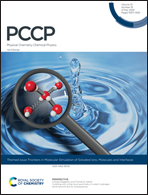Glucose in dry and moist ionic liquid: vibrational circular dichroism, IR, and possible mechanisms†
Abstract
Ionic liquids and their mixtures with water show remarkable features in cellulose processing. For this reason, understanding the behavior of carbohydrates in ionic liquids is important. In the present study, we investigated three D-glucose isomers (α, β and open-chain) in 1-ethyl-3-methylimidazolium acetate in the presence and absence of water, through ab initio molecular dynamics simulations. In the complex hydrogen bonding network of these mixtures, the most interesting observation is that upon water addition every hydrogen bond elongates, except the glucose–glucose hydrogen bond for the open-chain and the α-form which shortens, clearly showing the beginning of the crystallization process. The ring glucose rearranges from on-top to in-plane and the open form changes from a coiled to a more linear arrangement when adding water which explains the contradiction that the center of mass distances of the glucose molecules with other glucose molecules grow while the hydrogen bonds shorten. The appearance of coiled open forms indicates that the previously suggested isomerization between these forms is possible and might play a role in the solubility of the related carbohydrates. The calculated IR and VCD spectra reveal insight into the intermolecular interactions, with good to excellent agreements with experimental spectra. Investigating the role of the cation, distances between the acidic carbon atom of the cation and the glucose carbon atom where ring closure and opening occurs are found, which are way shorter than dispersion-like interactions between aliphatic hydrocarbons.

- This article is part of the themed collection: Frontiers in Molecular Simulation of Solvated Ions, Molecules and Interfaces


 Please wait while we load your content...
Please wait while we load your content...